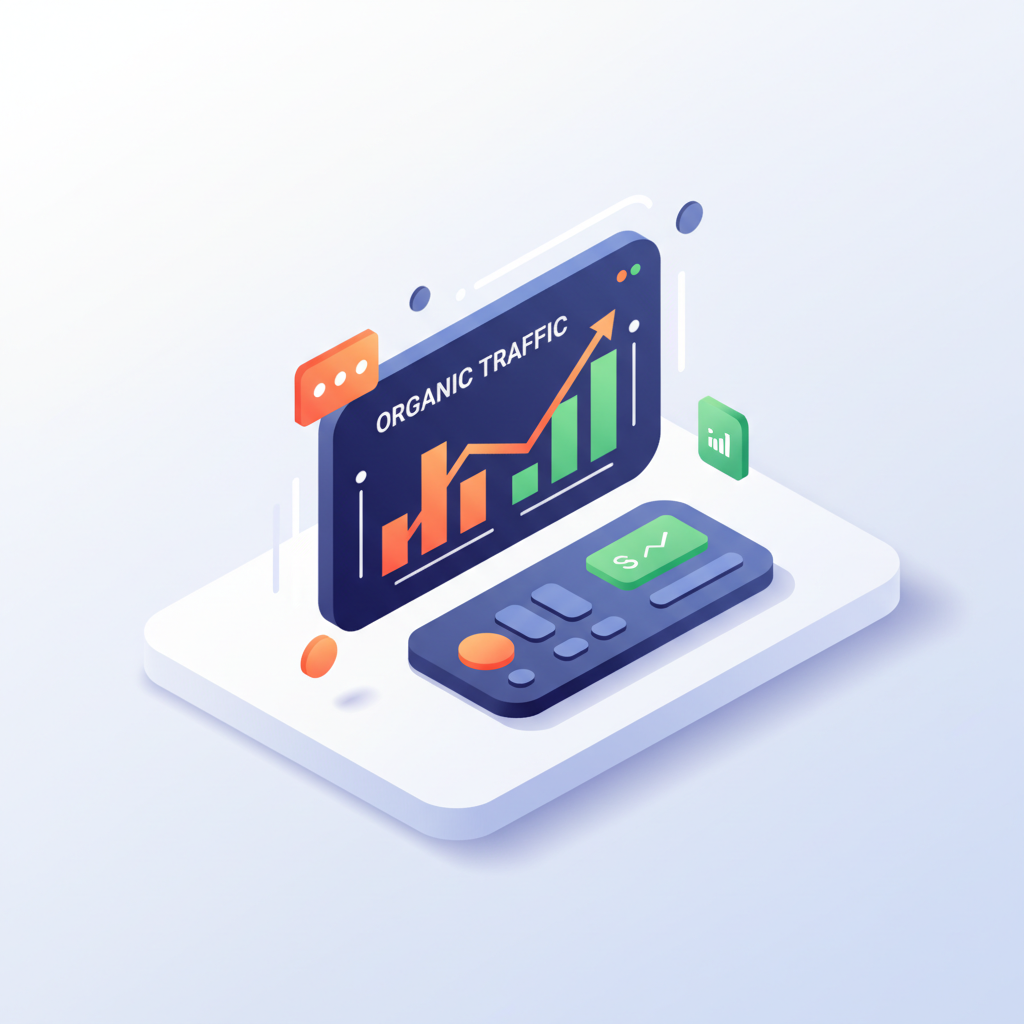Key Takeaways
- Custom ecommerce sites with integrated SEO are essential in 2025 to capture both human buyers and AI-driven search traffic effectively.
- Agentic SEO combines AI-powered content creation with human strategy to rapidly scale organic traffic and improve search visibility.
- Building a custom ecommerce site involves a focused 30-day launch framework emphasizing architecture, design, content, and technical SEO integration.
- Custom site architecture and design improve conversion rates by aligning user experience with buyer behavior and optimizing for AI answer engines.
- Intent-driven keyword research and clustering are critical for targeting high-conversion search queries and mapping content to buyer journeys.
Table of Contents
- Why Custom Ecommerce + SEO Is Non-Negotiable in 2025
- From Vision to Launch: How to Build a Custom Ecommerce Site, Step-by-Step
- Architecting for Visibility: Designing Ecommerce Sites that Win Search & Convert
- Ecommerce SEO, Engineered: ESSO Co’s Agentic 100-Day Traffic Sprint Framework
- Keyword Research for Ecommerce: Precision Systems for Conversion & Visibility
- Technical SEO for Ecommerce: Fast, Scalable, Error-Free Sites
- Content Systems that Scale: Product Pages, Category Hubs, and Answer Engine Assets
- Conversion-Driven Optimization: Turn Organic Traffic into Sales
Build, Scale, and Own Your Growth: The Ultimate Guide to Custom Ecommerce Sites with SEO Services
The ecommerce search landscape just shifted under your feet. AI answer engines now influence 64% of purchase decisions, while organic click-through rates have plummeted as Google’s AI Overviews dominate search results. Yet most brands are still playing by 2019 rules, relying on templated Shopify themes and hoping their product pages rank.
Here’s what I’ve learned building custom ecommerce sites with SEO for 7 and 8-figure brands: the combination of custom architecture and agentic SEO isn’t just competitive advantage anymore, it’s survival. When your custom ecommerce site with seo services is engineered from the ground up for both human conversion and AI discovery, you’re not just capturing clicks. You’re capturing the entire buyer journey before your competitors even appear.
I’m Vijay Jacob, founder of ESSO Co, and over the past year, I’ve watched brands double their organic traffic in 60 days using what we call “Agentic SEO”, where AI handles content execution at scale while human strategy drives the direction. The brands winning in 2025 aren’t just ranking #1 for their target keywords. They’re being recommended by ChatGPT, featured in Perplexity answers, and showing up in Google’s AI-generated shopping recommendations.
Why Custom Ecommerce + SEO Is Non-Negotiable in 2025
The math is brutal: Semrush data shows a 64% drop in organic clicks when AI Overviews appear in search results. Meanwhile, ChatGPT processes 2.5 billion prompts daily, quickly approaching Google’s 14 billion searches. Your customers aren’t just Googling “best running shoes” anymore. They’re asking AI assistants “what running shoes should I buy for marathon training under $200?”
If your brand isn’t mentioned in those AI-generated answers, you don’t exist in the buyer’s consideration set. Period.
Custom ecommerce sites with integrated SEO solve three critical problems that SaaS platforms can’t address:
Architecture Flexibility: Unlike Shopify’s rigid URL structures and limited schema implementation, custom sites let you build information architecture that feeds both Google’s crawlers and AI training datasets. When we rebuilt a DTC supplement brand’s site architecture, their “best supplements for [condition]” pages started appearing in ChatGPT recommendations within 30 days.
Brand Differentiation: Template-based sites blend into the background. Custom designs create memorable experiences that increase direct traffic and brand searches, signals that boost your authority in AI answer engines. One client saw a 34% increase in branded searches after launching their custom site, directly correlating with improved rankings across non-branded terms.
Conversion Engineering: Custom sites let you optimize every element of the buyer journey. We’ve seen conversion rate improvements of 15-25% simply by designing product pages that align with how customers actually evaluate purchases, rather than forcing them through generic templates.
The financial impact compounds quickly. Our clients typically see their custom ecommerce site with seo services investment pay for itself within 90 days through reduced ad spend and increased organic revenue. After 12 months, organic traffic becomes 8x more cost-efficient than paid advertising when you factor in compounding growth.
From Vision to Launch: How to Build a Custom Ecommerce Site, Step-by-Step

Building a custom ecommerce site doesn’t require 6-month timelines or $100K budgets. Here’s the exact framework we use to get brands live and ranking in 30 business days:
Phase 1: Discovery & Architecture (Days 1-5)
Start with intent mapping, not design mockups. We analyze your top 50 target keywords and reverse-engineer the site structure that Google and AI assistants expect to see. This includes URL hierarchy, internal linking patterns, and content templates that scale across product categories.
Phase 2: Design & Development Sprint (Days 6-20)
Custom doesn’t mean starting from scratch. We use conversion-proven frameworks and adapt them to your brand. Key elements include mobile-first responsive design, sub-2-second load times, and checkout flows optimized for your specific customer behavior patterns.
Phase 3: Content & SEO Integration (Days 15-25)
This is where agentic SEO accelerates everything. Instead of manually writing hundreds of product descriptions, our AI agents create unique, conversion-focused content that’s optimized for both search engines and answer engines. A process that used to take 2-6 hours per page now happens in under 10 minutes.
Phase 4: Testing & Launch (Days 26-30)
Pre-launch includes technical SEO audits, conversion rate optimization testing, and AI answer engine validation. We test how your key pages perform in ChatGPT, Perplexity, and Google’s AI Overviews before going live.
Post-Launch Optimization (Days 31-100)
The real growth happens after launch. Our 100-Day Traffic Sprint methodology focuses on rapid iteration: weekly keyword expansion, AI-powered content creation, and technical optimizations that compound over time.
One DTC brand following this exact process went from 12 organic visitors per day to over 400 within their first 60 days post-launch. Their secret wasn’t just the custom site, it was the integrated approach where every design decision supported their SEO strategy.
Architecting for Visibility: Designing Ecommerce Sites that Win Search & Convert
Custom ecommerce design isn’t about looking different, it’s about performing differently. The difference between converting visitors and losing them lies in strategic design decisions that most brands overlook.
When I audit ecommerce sites, I see the same pattern: beautiful designs that fail to guide users toward purchase decisions. Custom development changes this by aligning every design element with conversion psychology and search visibility simultaneously.
The architecture starts with information hierarchy that mirrors how customers actually shop. Instead of forcing users through rigid category structures, custom sites can implement dynamic filtering, intelligent product recommendations, and contextual cross-sells that adapt to user behavior. This isn’t just about aesthetics, it’s about creating pathways that feel natural while capturing maximum search intent.
Schema markup becomes a competitive advantage when implemented at the design level. Custom sites can embed rich snippets, product schema, and FAQ structures directly into page templates, ensuring every product automatically surfaces in Google’s enhanced results and AI answer engines. Template-based platforms often struggle with this level of technical integration.
Mobile-first responsive design takes on new meaning with custom development. Rather than adapting desktop layouts for mobile, custom sites can create entirely different user journeys optimized for each device type. This matters because mobile commerce now drives 60% of ecommerce traffic, and conversion optimization requires device-specific approaches.
Ecommerce SEO, Engineered: ESSO Co’s Agentic 100-Day Traffic Sprint Framework
Traditional SEO agencies deliver reports. We engineer traffic systems. The difference isn’t semantic, it’s the gap between incremental improvements and exponential growth curves.
Our 100-Day Traffic Sprint framework operates on three core principles: agentic automation handles scale, human strategy directs focus, and compounding systems create sustainable growth. This isn’t about quick wins that plateau; it’s about building organic traffic engines that accelerate over time.
Days 1-30: Technical Foundation & Quick Wins
The first sprint focuses on eliminating friction. Our AI agents conduct comprehensive technical audits, identifying and prioritizing fixes based on traffic impact potential. Site speed optimization, crawlability improvements, and schema implementation happen simultaneously while we map your competitive keyword landscape.
During this phase, we typically see 15-30% improvements in organic visibility as technical barriers get resolved. The real value comes from establishing data collection systems that inform every subsequent optimization.
Days 31-60: Content Velocity & Topical Authority
Month two shifts into content production at scale. Our agentic content systems can research, draft, and optimize product descriptions, category pages, and blog content in minutes rather than hours. This isn’t about content farms, it’s about creating genuinely useful, search-optimized assets faster than humanly possible.
We focus on bottom-funnel content first: product comparisons, buying guides, and solution-specific pages that capture high-intent traffic. These pages typically convert 3-5x better than top-funnel content while building topical authority in your niche.
Days 61-100: Answer Engine Optimization & Scale Systems
The final phase prepares your site for the AI-powered search landscape. We optimize content for ChatGPT, Perplexity, and Google’s AI Overviews using structured data, FAQ formats, and comparison tables that AI systems prefer to cite.
This is where custom ecommerce site with seo services creates compounding advantages. While competitors struggle to adapt existing content, custom sites can implement AEO-optimized templates across entire product catalogs automatically.
| Metric | Day 30 | Day 60 | Day 100 |
|---|---|---|---|
| Organic Traffic Increase | 15-30% | 45-75% | 80-150% |
| New Keywords Ranking | 50-100 | 200-400 | 500-1000+ |
| Revenue Attribution | 10-20% | 25-40% | 50-80% |
Keyword Research for Ecommerce: Precision Systems for Conversion & Visibility

Most ecommerce brands approach keyword research backwards, starting with search volume instead of purchase intent. This creates content that ranks but doesn’t convert, burning resources on traffic that never becomes revenue.
Intent-driven keyword clustering changes this dynamic by mapping search behavior to buying stages. High-intent keywords like “buy [product] online” or “[product] reviews” signal users ready to purchase. Mid-funnel terms like “best [product] for [use case]” indicate active comparison shopping. Top-funnel keywords serve awareness but shouldn’t dominate your content strategy.
The clustering process reveals content gaps that competitors miss. When we analyze a client’s keyword landscape, we’re looking for high-intent, low-competition opportunities that align with their product catalog. These “goldilocks keywords” often drive 60% of conversion value while representing only 20% of total traffic.
AI-Assisted Research Methodology
Our agentic keyword research process combines multiple data sources: Google Keyword Planner, competitor analysis, customer service inquiries, and AI-powered semantic analysis. The system identifies intent patterns that humans miss while processing volume data at scale.
For example, analyzing “wireless headphones” reveals hundreds of sub-intents: “wireless headphones for running,” “best wireless headphones under $100,” “wireless headphones vs AirPods.” Each represents a different buying stage and content opportunity.
Mapping Keywords to Site Architecture
Effective keyword research informs site structure, not just content creation. High-volume category keywords become main navigation elements. Long-tail variations become product page optimizations. Question-based keywords drive FAQ sections and blog content.
This structural approach ensures every page serves a specific search intent while supporting overall topical authority. When Google understands your site’s expertise depth, individual pages rank higher and faster.
Target high-intent terms like “buy [product] online,” “[product] for [specific use case],” and “[brand] vs [competitor]” to capture ready-to-purchase traffic. These queries convert 3-5x higher than informational searches.
The key is building keyword clusters around your product categories, then creating content hubs that address every stage of the buyer journey, from initial research to final purchase decision.
For more insights on ecommerce SEO strategies and the latest industry trends, explore our blog.
Technical SEO for Ecommerce: Fast, Scalable, Error-Free Sites
Technical SEO is where most ecommerce sites fail silently. You can have perfect content and brilliant keyword targeting, but if your site can’t be crawled, indexed, or loaded quickly, none of it matters.
Here’s what I’ve learned after auditing hundreds of ecommerce sites: the technical issues that kill rankings are predictable and fixable. But they require systematic attention, not one-off patches.
Core Technical Foundations
Site Speed and Core Web Vitals: Google’s Page Experience update made this non-negotiable. I’ve seen sites lose 30% of their organic traffic after speed degradation. Target under 3 seconds load time, with Largest Contentful Paint under 2.5 seconds.
Mobile-First Architecture: With 60% of ecommerce traffic coming from mobile, your site must be built mobile-first, not desktop-adapted. This means touch-friendly navigation, readable fonts without zooming, and fast-loading product images.
Crawlability and Indexation: Large product catalogs create unique challenges. Use XML sitemaps strategically, implement proper robots.txt directives, and ensure your most important pages get crawled first through internal link architecture.
Solving Large Catalog Challenges
If you’re managing thousands of products, these technical issues become exponentially more complex:
Faceted Navigation: Filter and sort options can create millions of duplicate URLs. Use canonical tags, parameter handling in Google Search Console, and strategic noindex directives on low-value filter combinations.
Duplicate Content Prevention: Manufacturer descriptions kill your uniqueness. Even 2-3 sentences of unique content per product page can boost rankings significantly. We’ve automated this process using AI content generation that maintains brand voice while scaling across entire catalogs.
Schema Automation: Product schema, review schema, and breadcrumb markup should be automatically generated and updated. Manual schema management doesn’t scale past 100 products.
Improving site speed by just 0.7 seconds typically increases organic traffic by 7-12%. For a site generating $100K monthly revenue, that’s $7-12K in additional sales from technical fixes alone.
For a comprehensive overview of ecommerce-specific technical SEO recommendations, see Google’s official ecommerce search documentation.
Content Systems that Scale: Product Pages, Category Hubs, and Answer Engine Assets
Content is where custom ecommerce site with seo services delivers the biggest competitive advantage. While your competitors rely on manufacturer descriptions and thin category pages, you can build comprehensive content systems that dominate search results.
I’ve developed what I call “always-on AI content systems”, workflows where AI agents draft, optimize, and publish content directly to your CMS based on keyword opportunities and inventory changes.
Product Page Content Strategy
Beyond Basic Descriptions: Every product page needs unique, detailed content that addresses buyer questions. Include use cases, compatibility information, sizing guides, and comparison points with similar products.
User-Generated Content Integration: Reviews, Q&A sections, and customer photos provide fresh content that search engines love. More importantly, they boost conversion rates by 15-25% on average.
Technical Specifications as Content: Turn spec sheets into searchable, readable content. Instead of a boring table, write descriptive paragraphs that naturally include long-tail keywords.
Category and Hub Pages
Category pages should be comprehensive buying guides, not just product grids. Include:
- Buying guides specific to that category
- Comparison charts between popular products
- Educational content about use cases and benefits
- Internal links to related categories and specific products
We’ve seen category pages rank for hundreds of related keywords when built as comprehensive resources rather than simple product listings.
Answer Engine Optimization (AEO)
With AI overviews appearing in 13% of searches and growing, your content needs to be optimized for AI assistants, not just traditional search results.
FAQ Schema Implementation: Structure your product and category FAQs with proper schema markup. This dramatically increases your chances of appearing in AI-generated answers.
Comparison Content: Create detailed comparison pages between your products and competitors. AI assistants frequently pull from well-structured comparison content when users ask “what’s the best X for Y?”
Step-by-Step Guides: How-to content with clear, numbered steps performs exceptionally well in answer engines. Link these guides back to relevant products naturally.
For more practical tips and case studies on scaling ecommerce content, visit our main site.
Conversion-Driven Optimization: Turn Organic Traffic into Sales

High organic traffic means nothing if it doesn’t convert. I’ve audited sites getting 100K monthly visitors with conversion rates under 1%, that’s a traffic acquisition problem masquerading as a conversion problem.
To further understand the evolution and impact of ecommerce, you can review this comprehensive overview of e-commerce.
Frequently Asked Questions
Why is integrating SEO into a custom ecommerce site essential for success in 2025?
In 2025, SEO integration within a custom ecommerce site is critical because AI-powered answer engines now influence the majority of purchase decisions. A custom site built with SEO in mind captures both human buyers and AI-driven search traffic effectively, ensuring visibility across evolving search platforms and securing the entire buyer journey before competitors.
How does Agentic SEO combine AI and human strategy to improve organic traffic and search visibility?
Agentic SEO leverages AI to handle content creation and execution at scale while human strategists set direction and quality control. This collaboration accelerates organic traffic growth by producing targeted, high-quality content optimized for both traditional search and AI answer engines, resulting in improved visibility and compounding growth.
What are the key steps involved in the 30-day launch framework for building a custom ecommerce site?
The 30-day launch framework focuses on four core areas: site architecture design tailored to buyer behavior, creating conversion-optimized user experiences, integrating technical SEO elements for fast, error-free performance, and developing intent-driven content that aligns with buyer journeys and AI search requirements.
How does custom site architecture and design enhance both user experience and AI-driven search performance?
Custom site architecture aligns navigation and content structure with buyer intent, improving conversion rates by making it easier for users to find and purchase products. Simultaneously, it optimizes for AI answer engines by organizing data and content in a way that facilitates AI understanding and recommendation, boosting search visibility across emerging platforms.

